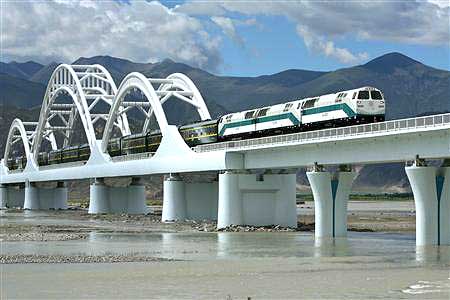Tibet, Islands on the sky train
A little more than 50 years after Chinese Communist soldiers marched into Tibet as conquerors, Chinese and Tibetan officials Saturday sped across the high mountain plateau in air-conditioned comfort aboard the world's highest sky train the Qinghai.

The Qinghai, named after Qinghai Province, originates in Xining, capitol of that region in central China, and proceeds west then south for more that 2500 miles to Lhasa, capitol of TAR (Tibet Autonomous Region) over some of the most forbidding, highest landscape on Earth. The Tibetan plateau averages an elevation of 16000 feet and has passes, like the Tangulla, which rises to 16,737 feet, (first area satellite images, Greener Earth.) Passengers are required to sign a waiver declaring that they understood the risks of traveling at such high altitude. The specially designed train cars are equipped with double-paned windows to protect against high-altitude ultraviolet radiation and, like passenger jets, there are outlets for oxygen masks near every seat, for passengers who need help coping with the thin air.
While most Tibetans expressed genuine national pride over the much-anticipated opening of the Qinghai Railway, some international protests were filed by environmentalists and people loyal to the exiled Tibetan government of His Holiness the Dalai Lama. Tibetan and Chinese officials declared the new railway a triumph of transportation engineering and a great boon to the economics and culture of the hitherto isolated region.
Much of the sky train is elevated, crossing deep ravines and high mountain passes with portions of it built on permafrost. Permafrost is a condition of soil that renders it as solid as bedrock when, because of elevation or latitude, water in sub surface soil remains frozen year around. Permafrost may be built upon with the same confidence engineers use when constructing footing on bedrock. The biggest challenge for the builders was keeping things cool. Construction work on permafrost can heat up the ground, as can the pounding of a thousand-ton train – the added pressure is translated into heat energy. In some places, the best solution was to build an elevated track: About 100 miles of the rail system are raised, allowing cold air to flow below the track and cool the ground. The sight of these stretches of raised railway in the otherwise untouched vastness of the plateau is surreal – a frozen ribbon of concrete floating above the landscape and disappearing into the distance.
In areas where elevated track didn’t make sense or proved too expensive, sections of the railway are lined with vertical pipes that circulate liquid nitrogen. In other places, hollow concrete pipes beneath the tracks create a reverse-insulating effect. Metal sunshades were also placed in a few south-facing locations to reduce warming from the sun.
The Chinese government has, for many years, used railway construction as a means toward an end in uniting far-flung, sometimes reluctant lands and people, much in the same way early American railroads connected the eastern States with the largely Spanish Republic of California and the Pacific coast. The Sky Rail is just such a geopolitically driven feat of engineering and social construction. The difference, if there is one, is that the Chinese government likely will not provide as much two-way commerce with the Tibetans as they will use the rail as a means of tightening their control over the onceindependent Kingdom. Lowland Chinese tourism, business and official government travel to the TAR is expected to grow by as much as 400% in the months immediately following the line’s opening.
Tibet remains one of the last traditional Buddhist states in the world and as such stands opposed to Chinese efforts at nation building. Chinese authority has declared Tibet's monotheistic government archaic and has proceeded methodically to close most of the traditional temples used by Tibetans. Those temples have been for generations the centerpieces of their social and civil culture. The eco tourism industry as well as Tibetan loyalists are concerned that the railway is a last ditch effort by the Chinese government to subdue the isolated province before world attention brought about by trend to global tourism shines a brighter light on the Himalayan highlands. Environmentalists are quick to point out that the railway, while it may be a feat of super-engineering for the moment, will prove disastrous in the short term as rising global temperatures begin to thaw the underlying permafrost. Some in China worry that the concrete piling may begin to sink as the permafrost below turns from a frozen solid into damp, seasonally spongy tundra. Some estimates are that this newest and brightest example of China’s expanding infrastructure may be in ruins within a decade.
However the outcome it may be fairly stated that with the opening of The Qinghai following closely on the heals of last months completion of Three Gorges Dam China appears determined to make the most of its new found economic stability by investing heavily in projects that seem certain to secure a future for China and her 3.2 billion people.
by Harlan Weikle
Greener Magazine
Next week: A Chinese Lake, the race for global shipping dominance.
::some portions of this report were contributed by Xinhua, the CN Government News Agency

The Qinghai, named after Qinghai Province, originates in Xining, capitol of that region in central China, and proceeds west then south for more that 2500 miles to Lhasa, capitol of TAR (Tibet Autonomous Region) over some of the most forbidding, highest landscape on Earth. The Tibetan plateau averages an elevation of 16000 feet and has passes, like the Tangulla, which rises to 16,737 feet, (first area satellite images, Greener Earth.) Passengers are required to sign a waiver declaring that they understood the risks of traveling at such high altitude. The specially designed train cars are equipped with double-paned windows to protect against high-altitude ultraviolet radiation and, like passenger jets, there are outlets for oxygen masks near every seat, for passengers who need help coping with the thin air.
While most Tibetans expressed genuine national pride over the much-anticipated opening of the Qinghai Railway, some international protests were filed by environmentalists and people loyal to the exiled Tibetan government of His Holiness the Dalai Lama. Tibetan and Chinese officials declared the new railway a triumph of transportation engineering and a great boon to the economics and culture of the hitherto isolated region.
Much of the sky train is elevated, crossing deep ravines and high mountain passes with portions of it built on permafrost. Permafrost is a condition of soil that renders it as solid as bedrock when, because of elevation or latitude, water in sub surface soil remains frozen year around. Permafrost may be built upon with the same confidence engineers use when constructing footing on bedrock. The biggest challenge for the builders was keeping things cool. Construction work on permafrost can heat up the ground, as can the pounding of a thousand-ton train – the added pressure is translated into heat energy. In some places, the best solution was to build an elevated track: About 100 miles of the rail system are raised, allowing cold air to flow below the track and cool the ground. The sight of these stretches of raised railway in the otherwise untouched vastness of the plateau is surreal – a frozen ribbon of concrete floating above the landscape and disappearing into the distance.
In areas where elevated track didn’t make sense or proved too expensive, sections of the railway are lined with vertical pipes that circulate liquid nitrogen. In other places, hollow concrete pipes beneath the tracks create a reverse-insulating effect. Metal sunshades were also placed in a few south-facing locations to reduce warming from the sun.
The Chinese government has, for many years, used railway construction as a means toward an end in uniting far-flung, sometimes reluctant lands and people, much in the same way early American railroads connected the eastern States with the largely Spanish Republic of California and the Pacific coast. The Sky Rail is just such a geopolitically driven feat of engineering and social construction. The difference, if there is one, is that the Chinese government likely will not provide as much two-way commerce with the Tibetans as they will use the rail as a means of tightening their control over the onceindependent Kingdom. Lowland Chinese tourism, business and official government travel to the TAR is expected to grow by as much as 400% in the months immediately following the line’s opening.
Tibet remains one of the last traditional Buddhist states in the world and as such stands opposed to Chinese efforts at nation building. Chinese authority has declared Tibet's monotheistic government archaic and has proceeded methodically to close most of the traditional temples used by Tibetans. Those temples have been for generations the centerpieces of their social and civil culture. The eco tourism industry as well as Tibetan loyalists are concerned that the railway is a last ditch effort by the Chinese government to subdue the isolated province before world attention brought about by trend to global tourism shines a brighter light on the Himalayan highlands. Environmentalists are quick to point out that the railway, while it may be a feat of super-engineering for the moment, will prove disastrous in the short term as rising global temperatures begin to thaw the underlying permafrost. Some in China worry that the concrete piling may begin to sink as the permafrost below turns from a frozen solid into damp, seasonally spongy tundra. Some estimates are that this newest and brightest example of China’s expanding infrastructure may be in ruins within a decade.
However the outcome it may be fairly stated that with the opening of The Qinghai following closely on the heals of last months completion of Three Gorges Dam China appears determined to make the most of its new found economic stability by investing heavily in projects that seem certain to secure a future for China and her 3.2 billion people.
by Harlan Weikle
Greener Magazine
Next week: A Chinese Lake, the race for global shipping dominance.
::some portions of this report were contributed by Xinhua, the CN Government News Agency



10:55 AM









<< Home